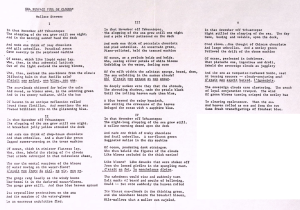listen
Sea Surface full of clouds
ORCHESTRAL
Piano Concerto, Mvt 1
CHAMBER MUSIC WITH PIANO
Suite for Recorder and Piano
Postlude For Trio
SOLO WORKS
Prelude for Piano
Zwei Kleine Pückstückchenleine
Diatonic Study for Harp
Chromatic Study for Harp
SPECIAL MICROTONAL WORKS
Excerpt from "Nine Preludes"
Excerpt from "Nine Preludes"
Study on the 7th partial for woodwind quintet
Excerpt from 2nd Woodwind Quintet
Dream Songs
SONG CYCLES
The Falling Of The Leaves: 10. Under Ben Bulben, IV
A Wind of Fall: 4. Twilight Of The Wood
LIGHT AND SHADE
Shadows
Clava
What the Greek Sun Did To Me
Cluny Unicorn Tapestries
With Primeval Candor: Girl With Cello
With Primeval Candor: A Glass of Water
With Primeval Candor: The Lady and the Unicorn
With Primeval Candor: Evening Music
With Primeval Candor: Invocation
Quiet Homecoming: Homecoming
SMALL GROUPS OF SONGS
Borne by Warm Breezes: 1. Nocturne
Borne by Warm Breezes: 2. Words
Borne by Warm Breezes: 3. Refuge
INDIVIDUAL SONGS
Pretty Halcyon Days
Les Pas
WORKS FOR CHORUS
A Christmas message
The Cloisters
Psalm 121
Easter Scene From The Village
DRAMATIC WORKS
The Dybbuk
The village
Maman's First Aria
Maman's Second Aria
Maman's Third Aria
Maman's Fourth Aria
Tea and Empathy
Conversationalist
I'll Have To Start Looking Around Again
Make Up A Word
Finale
performing others' works
Brahms Liebeslieder #8
Brahms Liebeslieder #17
Mahler Song Recital (1968)
Gingheit Morgen ubers Feld
Ablösung im Sommer
Des Antonius von Padua Fischpredigt
Wer hat dies Liedlein erdacht?
O Mensch gib Acht
Revelge
Ich atmet’ einen linden Duft
Ich bin der Welt abhanden gekommen
Um Mitternach
Lob des hohen Verstandes
Mozart & Sousa: Die Sterne und Striche auf immer
Access to Queens college podcasts
Copyright © Joel Mandelbaum | Musician and Composer
Artwork by Ellen Mandelbaum
